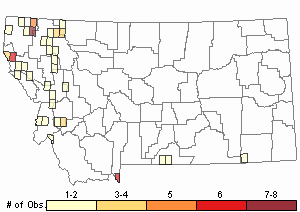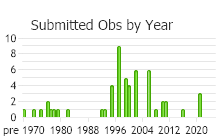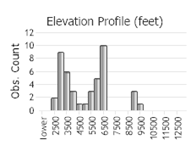View in other NatureServe Network Field Guides
NatureServe
Montana
Utah
Wyoming
Idaho
Wisconsin
British Columbia
South Carolina
Yukon
California
New York
Frosted Haircap Moss - Polytrichum piliferum
General Description
Plants: Acrocarpous. Short and stout, growing in uncrowded clumps of erect shoots; green or dark green, glaucous when young, becoming reddish brown with age (Flowers 1973). Stems (.5-) 1-4 cm high, simple, flexuose below, radiculose at the base, with crowded leaves at the tips (FNA 2007).
Leaves: Straight, the margins a little turned up and inward when dry, and spreading somewhat when wet, consisting of a blade (limb) above a clasping sheath (FNA 2007), 4-6 mm in length although shorter in dry areas (Flowers 1973); the blade narrowly lance-shaped, extending from the ovate sheath (Flowers 1973, FNA 2007), the margins abruptly folded up and inward, smooth to finely toothed near the apex; apex suddenly narrowed to the base of a long, often minutely- and sharply-toothed, hyaline hair point formed by the long-excurrent costa (Flowers 1973, FNA 2007); costa usually smooth abaxially and consisting of about 24-29 (Crum 1981) or as many as 40 lamellae (Flowers 1973).
Leaf Cells: Marginal lamina of one cell-layer, 5-8 cells in width, transparent, folding over the lamellae, the two margins overlapping distally; lamellae in profile appearing scalloped to finely toothed, (4-) 6-8 cells high, the marginal cells cone- to pear-shaped; sheath cells rectangular (4-6:1); cells of marginal lamina lengthened crosswise, sinuous, thick-walled, slanting in direction (more so closer to the apex), smaller near the margins (FNA 2007).
Diagnostic Characteristics
The only species in Polytrichum with the awn entirely hyaline (Vitt 1988).
P. piliferum lives in drier areas than the similar P. juniperinum and seldom forks (Vitt 1988). The latter species is larger and has reddish awns (FNA 2007).
Range Comments
Greenland; Canada: AB, BC, MB, NB, NL, NT, NS, NU, ON, PE, QC, YT; USA: AL, AK, AZ, CA, CO, CT, ID, IN, IA, KS, KY, LA, ME, MA, MI, MN, MO, MT, NE, NH, NJ, NM, NY, NC, ND, OH, OR, PA, SD, TN, UT, VT, VA, WA, WV, WI, WY; South America; Europe; Asia; Atlantic Islands (Falkland Islands, Macaronesia); Pacific Islands (Hawaii); Australia; Antarctica (FNA 2007). In Montana, known from Carbon, Deer Lodge, Flathead, Gallatin, Glacier, Judith Basin, Lake, Mineral, Missoula, Powder River, Ravalli, and Sanders Counties (Elliott 2016).
Observations in Montana Natural Heritage Program Database
Number of Observations: 73
(Click on the following maps and charts to see full sized version)
Map Help and Descriptions
Relative Density

Recency



 (Observations spanning multiple months or years are excluded from time charts)
(Observations spanning multiple months or years are excluded from time charts)
Habitat
Dry, open, shallow and well-drained sandy to gravelly surfaces atop rocks, in disturbed fields, burned areas, places with late snows further north (FNA 2007). Elevation: from 0 (FNA 2007) to 11,056 feet (Kosovich-Anderson 2015).
Ecology
A pioneer species in dry, exposed, sterile or well-drained sandy to rocky places (Crum 1981).
Some mosses are able to orient their hair points in such a way as to minimize water loss, a beneficial adaptation for plants living in environments that dry for extended periods (Malcolm 2000), which may aid this species in surviving the harsh environments where it lives.
Reproductive Characteristics
Dioicous. Setae 1-3 cm, stout, reddish brown to brown. Capsules nearly cubic with sharp angles, inclined, becoming horizontal at maturity, 2.5-3.5 mm (Crum 1981; FNA 2007). Perigonia a deep red and antheridia rosulate (FNA 2007).
References
- Literature Cited AboveLegend:
 View Online Publication
View Online Publication Crum, H.A. and L.E. Anderson. 1981. Mosses of Eastern North America. 2 volumes. Columbia University Press, New York. 1328 pp.
Crum, H.A. and L.E. Anderson. 1981. Mosses of Eastern North America. 2 volumes. Columbia University Press, New York. 1328 pp. Elliott, J.C. and A.K. Pipp. 2018. A Checklist of Montana Mosses (1880-2018). Updated 3 January, 2020. Montana Natural Heritage Program, Helena, Montana. 73 pp.
Elliott, J.C. and A.K. Pipp. 2018. A Checklist of Montana Mosses (1880-2018). Updated 3 January, 2020. Montana Natural Heritage Program, Helena, Montana. 73 pp. Flora of North America Editorial Committee, eds. 2007. Flora of North America North of Mexico. Volume 27. Bryophytes: Mosses, Part 1. Oxford University Press, Inc., NY. xxi + 713 pp.
Flora of North America Editorial Committee, eds. 2007. Flora of North America North of Mexico. Volume 27. Bryophytes: Mosses, Part 1. Oxford University Press, Inc., NY. xxi + 713 pp. Flowers, S. 1973. Mosses: Utah and the West. Brigham Young University, Provo, Utah. 567 p.
Flowers, S. 1973. Mosses: Utah and the West. Brigham Young University, Provo, Utah. 567 p. Kosovich-Anderson, Y. I. 2015. Mosses of the Rocky Mountains in Wyoming, U.S.A.: New Altitudinal Records for North America. Arctoa 24:141-147.
Kosovich-Anderson, Y. I. 2015. Mosses of the Rocky Mountains in Wyoming, U.S.A.: New Altitudinal Records for North America. Arctoa 24:141-147. Malcolm, W. M., and Nancy Malcolm. 2000. Mosses and Other Bryophytes: An Illustrated Glossary. Nelson, New Zealand: Micro-Optics Press.
Malcolm, W. M., and Nancy Malcolm. 2000. Mosses and Other Bryophytes: An Illustrated Glossary. Nelson, New Zealand: Micro-Optics Press. Vitt, D. J. Marsh, and R. Bovey. 1988. Mosses, Lichens & Ferns of Northwest North America. Seattle, WA: University of Washington Press. 296 p.
Vitt, D. J. Marsh, and R. Bovey. 1988. Mosses, Lichens & Ferns of Northwest North America. Seattle, WA: University of Washington Press. 296 p.
- Additional ReferencesLegend:
 View Online Publication
View Online Publication
Do you know of a citation we're missing? Elliot, J. C. 1993. Second checklist of Montana mosses. Unpublished report. U.S. Forest Service, Region 1. Missoula, MT. 45 pp.
Elliot, J. C. 1993. Second checklist of Montana mosses. Unpublished report. U.S. Forest Service, Region 1. Missoula, MT. 45 pp. Lawton, E. 1971. Keys for the Identification of the Mosses on the Pacific Northwest. Reprinted from 'Moss Flora of the Pacific Northwest'. Published as Supplement No. 2 of the Journal of the Hattori Botanical Laboratory. Nichinan, Miyazaki, Japan. 66 pp.
Lawton, E. 1971. Keys for the Identification of the Mosses on the Pacific Northwest. Reprinted from 'Moss Flora of the Pacific Northwest'. Published as Supplement No. 2 of the Journal of the Hattori Botanical Laboratory. Nichinan, Miyazaki, Japan. 66 pp. Lawton, E. 1971. Moss Flora of the Pacific Northwest. Hattori Botanical Laboratory. Japan: Yamabuki-cho, Shinjuku-ku, Tokyo. 362 pages plus appendices.
Lawton, E. 1971. Moss Flora of the Pacific Northwest. Hattori Botanical Laboratory. Japan: Yamabuki-cho, Shinjuku-ku, Tokyo. 362 pages plus appendices.
- Web Search Engines for Articles on "Frosted Haircap Moss"





